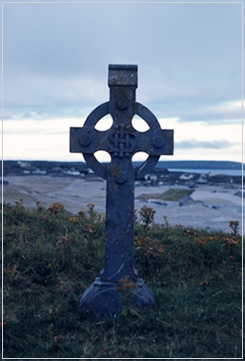
aran islands
by virgilio boccardi journalist
In September 1972 I was in Ireland to make a
television
movie about the Isles of Aran,
three small islands of fishermen and emigrants lost
in the Atlantic Ocean, which, about forty years
earlier, the film director Robert J. Flaherty,
American by adoption but Irish by birth, had made
famous with his
film ”Man of Aran“. I had a
small crew with me which included Etta Lisa
Basaldella who was at the beginning of her
television career and was acting as interpreter and
continuity person.
I already knew the Aran Isles,
having been there a few years before as a curious
tourist and been fascinated by the desolate
landscape with its hundreds of dry stone walls
bounding minute plots of green; by the thatched-roof
cottages; by the curraghs, boats made from wicker
and tarred canvas; by the remains of small
monasteries and abandoned cemeteries and by the Dun
Aengus a massive fortress, built perhaps by the Fir
Bolg, an Irish people dating back to 3.200 B.C..
I had promised myself I would return to record on
film the slow flow of days, the toil and the
struggles of the inhabitants of these forgotten tiny
islands with the sea and the wind. I wished to
document what had changed after forty years, after
Flaherty. I told Etta Lisa what I was hoping to do
while we made our way across Ireland to Galway,
where the “Naom Eanna”, a sort of cart, was waiting
to ferry us to Inishmore, the largest island.
Etta Lisa had a camera with two lenses. I distinctly
remember her energy; there was not one Celtic cross,
or church, or cemetery unworthy of being
immortalised by her camera. I would see her perched
on a wall or lying on the grass, or on her knees;
she seemed an inveterate professional right from the
start. It was above all during our stay on these
islands that I began to appreciate her profound
sensibility, how she enthused over various subjects,
how she would frame the object to be photographed so
as not to leave out any detail. It was on the Aran
Isles that Etta Lisa confessed to me that this was
her first foray into the world of photography and
how she was only beginning to realise how much this
art form fascinated her.
The camera was about to
become her most important means of expression. And
so it did.
In her wanderings over the world - in
Africa, Oceania, Europe and the Americas - her
photographs are not subordinate to a particular
event, it is their evocative potential which brings
them alive and, through their intrinsic power, we
see the significance which lies beyond the moment in
which they were taken. For, more than this actual
moment, Etta Lisa is above all interested in the
person as a part of his/her environment: faces,
hands, eyes.
On the Aran Isles too Etta Lisa
embraced the synthesis of this desolate land,
transferring its atmosphere onto rolls film. Through
her photographs she tells a meaningful, never
banal, story, steeped in a poetic aura. She even
manages to portray the fundamental truth of a great
event rendering it perceptible to all.
Instinctively Etta Lisa has learnt the lesson put
forward by the great Maestro Henri Cartier-Bresson:
”In order that a photograph is able to convey its
significance in all its intensity, formal
relationships must be strictly established.
Photography implies the recognition of rhythm in a
tangible world. The composition is not an element
added later...
rather it is endowed with its own
essentials and is impossible to separate the
contents from the style“.
<back
